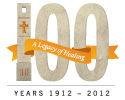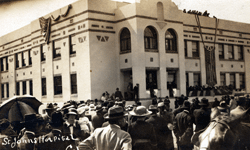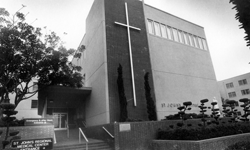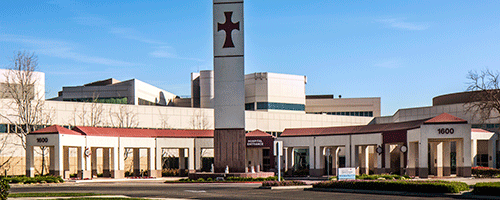St. John’s Centennial
100 Years of Service at St. John’s Hospitals
St. John’s Hospitals: Our Purpose is Health. Our Spirit is Strong.
| In September 2011, St. John’s Hospitals honored the arrival of the Sisters of Mercy to Oxnard to start a hospital. The Sisters came at the request of Reverend Laubacher, a local religious leader who in 1911 recognized that vital healthcare services were needed in Oxnard. In the spring of 2012, we recognized another major milestone in our hospital’s history as we celebrated the centennial of St. John’s Regional Medical Center in Oxnard. While we celebrate these two momentous occassions, we begin the next century with a new identity dedicated to the strength of the human spirit. |  |
St. John’s Regional Medical Center Through the Years
Our facility has transitioned several times since the hospital opened in 1912 to accommodate for the increasing patient population. After only a few short years as a small, six-room wooden structure, St. John’s opened a 25-bed hospital in 1915. According to Rev. Laubacher, “The doors of this building are thrown open to the sick and suffering, regardless of creed or color.” By 1952, the hospital had again outgrown its building, so a third hospital with 75 beds was opened to serve the booming post-war population. Finally, St. John’s Regional Medical Center opened in its current location in 1992. The 365,000-square-foot, state-of-the-art medical center is where St. John’s in Oxnard is located today.

1915 Hospital
|

1952 Hospital |

Present-day Hospital |
|
100 Years: A Legacy of Healing
Over the past 100 years, St. John’s has celebrated many milestones, some of which include:
1831: Irish heiress Catherine McAuley begins caring for poor women and children in Dublin, Ireland in 1827. To ensure her mission endures, Catherine founds the Sisters of Mercy in 1831.
1911: Reverend John Laubacher, pastor of Santa Clara Parish, invites the Sisters of Mercy to the growing community of Oxnard to help start a hospital. A delegation led by J.A. Driffel, manager of the Sugar Beet Factory, welcomes the Sisters when they arrive from San Diego. The Sisters collaborate with local ranchers, farmers, doctors, and business leaders to make the hospital a reality. The hospital is named after Rev. Laubacher’s patron saint, St. John the Evangelist.
1912: Rancher John Borchard and his family donate nine acres of land for the hospital and $20,000 to perpetually endow two beds for the poor. The first hospital is a green, six-room wooden building where the Sisters care for patients while funds are raised and a larger building is constructed. Oxnard pioneers John Borchard, J.A. Driffill, C.J. Elliott, Charles Donlon, W. H. Lathrop, L. Lehmann, and A. Levy build the temporary structure. Sister Mary Gabriel Gardiner from El Centro, California serves as the hospital’s first administrator.
1914: Dr. William R. Livingston introduces “Twilight Sleep” for delivering babies. Patients are injected with morphine and an amnesia-inducing drug to lessen the pain and erase all memory of it. Expectant mothers come from afar to experience “painless childbirth.” Dr. Livingston’s first delivery using this method is the grandson of John Borchard.
1915: Bishop Thomas J. Conaty blesses and dedicates St. John’s second hospital, a 25-bed building that costs $76,072 to construct. Rev. Laubacher declares that, “The doors of this building are thrown open to the sick and suffering, regardless of creed or color.”
1927: The American College of Surgeons grants St. John’s standardization approval in recognition of its excellent patient care.
1928: Statue of St. John the Evangelist Blessed.
1936: Modern X-Ray Department put into operation.
1940: New maternity ward opens.
1940: St. John’s raises chickens and vegetables to feed patients.
1941 – 43: Navy orderlies supplement nursing staff.
1950: John Maulhardt heads hospital campaign committee.
1952: Humanitarians organized to raise needed funds.
1952: Cardinal James Francis McIntyre dedicates the third St. John’s hospital, a two-story, 75-bed facility to serve Oxnard’s booming post-war population.
1952: The Humanitarians Gift Society and the St. John’s Auxiliary form to help raise funds for the hospital through social events and personal donations and to promote volunteerism.
1957: St. John’s opens its own in-house pharmacy. Prior to this, hospital staff had to procure medications for patients from a local pharmacy.
1958: The hospital installs a broadcasting console, the first of its kind in the area, allowing patients to watch television programs from their beds and piping music throughout the hospital.
